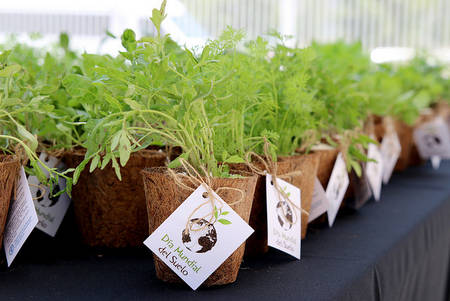
In 2002, the International Union of Soil Sciences (IUSS) made a resolution proposing the 5th of December be declared World Soil Day (WSD) in order to celebrate the importance of soil as a critical component of the natural system and as a vital contributor to human well-being. “Healthy soils for a healthy life” – this is the motto of the International Year of Soils 2015 (IYS2015) aimed at raising as much awareness as possible about the enormous role soil plays in food security. It is celebrated particularly by the global community of 60,000 soil scientists charged with responsibility of generating and communicating soil knowledge for the common good. GFAR supported the aims of IYS2015 through awarerness raising throughout 2015.
WSD 2016 is being celebrated on the 5th of December at FAO headquarters in Rome, FAO regional offices and through national and local events. In Nepal, Nepalese Society of Soil Science (NSSS), Soil Science Division, NARC, Khumaltar, Lalitpur, Nepal (1991) are actively involved in the soil related activities. This year NSSS has celebrated Soil Week (1st December to 5th December, 2016) throughout the country as a part of the celebration.
The theme of this year’s world soil day is ‘Soils and pulses, a symbiosis for life‘, underlining the interdependency of soil and pulses where each gains benefits from the other, as well as their importance to sustaining life. According to the father of soil science, Vasily Vasili'evich Dokuchaev, soil is vital to life and life is vital to soil. This means soil is an important part of our life where we take birth, grow, and finally die. However, this inseparable part of life is now degrading day by day in quality and becoming hazardous to us. The rapidly increasing population, high demand of food, industrialization and urbanization are key factors behind this degradation. Threats to soils such as acidification, bio-diversity loss, compaction, contamination, salinization and sodification, nutrient imbalance, sealing, organic carbon loss, and soil erosion have all been reported by FAO.
Based on these findings, FAO has prepared a series of nine postcards focusing on the main soil threats, produced together with a world map showing the condition and trend of each specific threat worldwide on the occasion of WSD 2016 to provide material for the worldwide campaign. These types of serious threats are making our life less sustainable; major factors in sustainability are environmental health, human health and well-being, and economic vitality. Thus arises the need for sustainable soil management activities, as recommended in the Sustainable Development Goals (SDGs) for 2030. Out of 17 SDGs, four are mainly targeted to soil which we need to adopt as soon as possible to secure a better future.
Pulses (also known as grain legumes) are the group of crops that includes dry beans, dry peas, chickpeas, and lentils. In most developing countries, pulses play a fundamental role as a low-fat, high fiber source of protein, an essential component of traditional food baskets. Pulses, by contributing about 10 percent in the daily protein intake and 5 percent in energy intake, are of particular importance for food security in low income countries where the major sources of proteins are non-animal products. In addition, pulses contain significant amounts of other essential nutrients like calcium, iron and lysine. Pulses are included in all ‘food baskets’ and dietary guidelines. Pulses play an important role in the Zero Hunger Challenge too, as they are carbohydrate- and protein- rich source of calories. On December 21st 2013, the General Assembly of the United Nations in New York voted to proclaim the International Year of Pulses 2016 (IYP2016), and GFAR Secretariat has again shared information and stories from the Partners in GFAR around these important elements of healthy diets.
Deteriorating soil quality can be minimized with incorporation of pulses in the field along with reduced soil erosion. According to FAO(2015) about 25 to 40 billion tones of top soil every year is carried away by erosion, significantly reducing crop yield and soil’s ability to store and cycle carbon, nutrients and water. It has been projected that a total reduction of 253 million tones of cereal production could occur by 2050. Pulses, when grown as cover crop, can help agriculture be more sustainable, reducing those kinds of risks. Thus, pulses help us to achieve a smaller agricultural footprint, production of nutritious and healthy food and many more sustainable opportunities.
This news was contributed by Dharmendra Kalauni, board member of the International Association of Students in Agricultural and Related Sciences, a Partner in GFAR.
Photo credit: FAO
